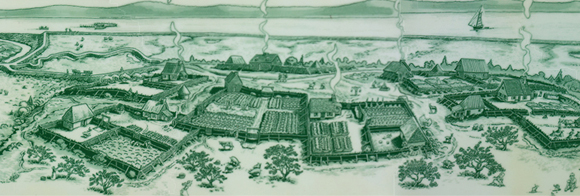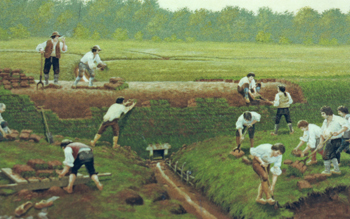A rich history
Melanson Settlement National Historic Site

The Melanson Settlement was an Acadian family settlement in the former Port-Royal area. It was located on the north shore of the Dauphin (now Annapolis) River, 6.5 kilometres down river from the town of Port-Royal (later Annapolis Royal.) Like the other Acadian settlements scattered along the river, the Melanson Settlement was an agricultural community where family members and neighbours worked co-operatively in the distinctive dykeland agriculture that was unique in colonial North America.
The houses, farm buildings and other architectural features of the settlement, as well as its orchards and upland gardens were situated on an upland terrace, overlooking the river, while its dykes and extensive fields were located on the salt marshes. Because it was on the approach to the fort at Port-Royal/Annapolis Royal, engineers recorded the Melanson Settlement on several 18th-century maps, providing an unusually detailed record for a pre-Deportation Acadian settlement.

Early years
The settlement was founded by Charles Melanson dit La Ramée and Marie Dugas after their marriage in about 1664. The couple built their home on the edge of the upland adjacent to the St.Charles marsh and, working with the Guilbeaux, their neighbours on the other side of the marsh, built the first dyke across the extensive marsh. Before Charles Melanson's death in about 1700, the couple had 14 children. As they grew to adulthood and married, eight of the children chose to remain in the family settlement, but not all at the same time.

British period
Under the British, the Melanson Settlement was part of a wider area sometimes known as Pointe aux Chesnes. Alexandre Robichaud and later Jean Melanson served as a deputy, representing the area in its dealings with the British governor and council at Annapolis Royal. The settlement on the upland grew slightly but seems to not have exceeded 10 to 12 households.
Dykeland agriculture continued at the site. A second dyke had been constructed by 1708. By 1725, the reclaimed marshland extended all the way to the river on both sides of the Melanson Settlement. Significant portions of the 17th and 18th-century Acadian dykes still survive.
By the time of the Deportation, four generations of Melansons had lived in the Melanson Settlement. Its residents were among the 1666 Acadians deported from the Annapolis Royal area in December of 1755. All of the buildings of the settlement probably were destroyed at this time.
History after the Deportation
In 1759, the north shore of the Annapolis Basin and the Annapolis River, including the lands of the Melanson Settlement, became part of Granville Township and was granted to New England Planters. The Planter and later landowners of the former Settlement continued the cultivation of the dykelands. They built their homes along a road, away from the upland terrace that held the remains of the Acadian buildings. Over the past 250 years, the Acadian foundations have remained relatively undisturbed.
Resources
BLEAKNEY, J. Sherman. Sods, soil, and spades: the Acadians at Grand Pré and their dykeland legacy, McGill University Press, 2007.
Nova Scotia Department of Agriculture and Marketing, Maritime Dykelands: the 350 year old struggle, 1987.
- Date modified :